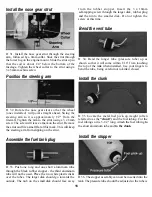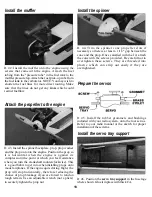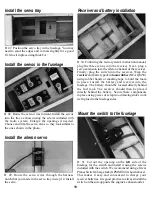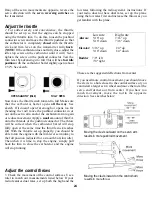
Ground Handling
Start with learning to steer the model on the ground
using the rudder and throttle. You should learn to
guide the airplane on the ground at various speeds and
directions. Be careful- you do not have brakes, so do
not get close to any obstacles.
Takeoff
Line up as straight into the wind as possible. Gradually
advance the throttle to get the model rolling. Advance
the throttle to full. Using rudder inputs, guide the plane
straight down the runway. Let the plane get up to flying
speed on the ground before lifting off. Once up to speed,
lift off by smoothly applying a little up elevator and
climb out gradually. Once a positive angle of attack is
achieved relax the up elevator input. Do not try to gain
altitude or turn until the airplane gains additional speed.
Flying
We recommend that you take it easy with your new
model for the first several flights and gradually "get
acquainted" with the airplane as your engine gets fully
broken-in. As you will see, this airplane is smooth and
very predictable. Your confidence will grow to the point
that flying is more fun than ever. Just remember to take
your time. Follow your instructor's advice and learn to
control the model in the many basic maneuvers
possible.
Your first flights should consist of mostly straight and
level flight with gentle turns to keep the model over
the field. These flights will give you practice at
coordinating your control inputs and maintaining the
proper orientation of the airplane. As mentioned
earlier, turns are accomplished by banking the aircraft
with the ailerons, then gently adding some back stick
(up elevator). Enough back stick should be held in to
keep the aircraft at a constant altitude —to stop
turning, apply opposite aileron (or rudder) to level the
wings, then release the sticks. The most common
mistake when learning to fly is over-control. Think of
pressure instead of large movements of the control
sticks. Add and practice one maneuver at a time,
learning how your BrightStar behaves in each one. For
ultra-smooth flying and normal maneuvers, we
recommend using the "low rate" settings as listed on
page 24. High rate control throws will give your
BrightStar enough control for loops, barrel rolls and
many other basic aerobatic maneuvers.
Landing
Because this is not a high-wing trainer, the BrightStar
will need a slightly different approach to landing.
Keeping the wings level during approach is
recommended to prevent "scuffing" the wing tips. The
BrightStar, being a low-wing trainer, will also land
slightly faster because it doesn't have the "glide
tendencies" of a high-wing trainer.
As with takeoffs, always land into the wind. Adding 2 to
3 "clicks" of up elevator trim will help slow the model
and allow easier landings. Line up with the runway and
reduce the throttle to idle. Glide the model down using
ailerons to keep the wings level and elevator to control
altitude. Be careful not to use too much elevator at
slower speeds. This could cause the airplane to stall too
close to the ground. If the airplane is coming in short,
gradually increase the throttle to get to the runway. If
you come in too fast, raise the throttle slowly and abort
the landing. Do not force the plane to land. Try again
with a slightly lower approach. Just before touchdown,
add in a little more elevator to flare the airplane for a
smooth touchdown. Perfect landings are difficult, so
practice them often.
Thank you for choosing the BrightStar. We hope that it
will be one of many, in a lifetime enjoyment of radio
control airplanes.

































